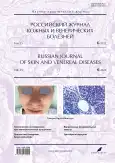Веррукозные эпидермальные невусы: некоторые аспекты патогенеза и клинические случаи
- Авторы: Окладникова Е.В.1, Селицкая О.В.1
-
Учреждения:
- Красноярский государственный медицинский университет имени профессора В.Ф. Войно-Ясенецкого
- Выпуск: Том 25, № 6 (2022)
- Страницы: 17-23
- Раздел: ДЕРМАТООНКОЛОГИЯ
- URL: https://journals.rcsi.science/1560-9588/article/view/132583
- DOI: https://doi.org/10.17816/dv112571
- ID: 132583
Цитировать
Аннотация
Веррукозные эпидермальные невусы ― гамартомы кератиноцитарных или эпидермальных придатков, которые располагаются на коже или слизистых оболочках в виде изолированных родимых пятен, реже имеют линейную локализацию. Патогенез веррукозных эпидермальных невусов до конца не определён: вероятно, развитие заболевания связано с генетическими мутациями во время эмбриогенеза и представляет собой особую форму кожного мозаицизма. Веррукозные эпидермальные невусы относятся к патологиям кожи, которые требуют внимания как потенциально опасные в аспекте развития злокачественных новообразований кожи и в связи с возможными трудностями их диагностики, в том числе дифференциальной.
Цель статьи ― анализ современных данных о патогенезе и дифференциальной диагностике веррукозных эпидермальных невусов на примере клинического случая линейной формы патологии. Исследования патогенеза веррукозных эпидермальных невусов показало разнонаправленные изменения экспрессируемых белков OGN, NT5C3A, ADD1, OLFML1, DHRS1, CALML5, SAMHD1, SFRP2, SPRR1B и SERPINB13 поражёнными клетками кожи при данном заболевании, в том числе при воспалительной линейной форме. Перечисленные белки участвуют в активации нейтрофилов, опосредованном нейтрофилами иммунитете и сигнальном пути p53, а также в клеточном ответе на цитокиновый стимул, клеточной адгезии, дифференцировке клеток Th1 и Th2. В представленном клиническом случае диагностика заболевания основана на клинической картине. Необходимость дифференциальной диагностики разных форм веррукозных эпидермальных невусов обусловлена их клинической, а иногда и гистологической схожестью с другими образованиями кожи. Провести дифференциальную диагностику помогают иммуногистохимическое исследование, генетический анализ с помощью секвенирования экзома поражённой кожи и протеомный анализ белков, экспрессируемых поражёнными клетками кожи.
Изучение механизмов развития веррукозных эпидермальных невусов поможет как с их дифференциальной диагностикой с другими заболеваниями кожи, так и с поиском новых подходов в консервативной терапии заболевания.
Полный текст
Открыть статью на сайте журналаОб авторах
Евгения Владимировна Окладникова
Красноярский государственный медицинский университет имени профессора В.Ф. Войно-Ясенецкого
Автор, ответственный за переписку.
Email: farmasis@yandex.ru
ORCID iD: 0000-0002-1909-222X
SPIN-код: 1220-9302
доцент
Россия, КрасноярскОльга Викторовна Селицкая
Красноярский государственный медицинский университет имени профессора В.Ф. Войно-Ясенецкого
Email: selickaya@inbox.ru
ORCID iD: 0000-0003-3960-1279
SPIN-код: 1993-5439
доцент
Россия, КрасноярскСписок литературы
- Elmas Ö.F., Akdeniz N. Dermoscopic aspect of verrucous epidermal nevi: New findings // Turk J Med Sci. 2019. Vol. 49, N 3. Р. 710–714. doi: 10.3906/sag-1811-27
- Тлиш М.М., Сычева Н.Л., Авдиенко И.Н., и др. Распространенный эпидермальный веррукозный невус: клинико-морфологический алгоритм постановки диагноза // Клиническая дерматология и венерология. 2014. Т. 12, № 6. С. 97–101. doi: 10.17116/klinderma2014697-101
- Ocampo-Garza J., Di Chiacchio N.G., Haneke E., et al. Verrucous epidermal naevus: A misleading diagnosis for 28 years // J Eur Acad Dermatol Venereol. 2018. Vol. 32, N 3. Р. e109–e110. doi: 10.1111/jdv.14597
- Kouzak S.S., Mendes M.S., Costa I.M. Cutaneous mosaicisms: Concepts, patterns and classifications // An Bras Dermatol. 2013. Vol. 88, N 4. Р. 507–517. doi: 10.1590/abd1806-4841.20132015
- Jackson R. The lines of Blaschko // Br J Dermatol. 1976. Vol. 96. Р. 349–359. doi: 10.1111/j.1365-2133.1976.tb00835.x
- Asch S., Sugarman J.L. Epidermal nevus syndromes: New insights into whorls and swirls // Pediatr Dermatol. 2018. Vol. 35, N 1. Р. 21–29. doi: 10.1111/pde.13273
- Atzmony L., Khan H.M., Lim Y.H., et al. Second-hit, postzygotic PMVK and MVD mutations in linear porokeratosis // JAMA Dermatol. 2019. Vol. 155, N 5. Р. 548–555. doi: 10.1001/jamadermatol.2019.0016
- Yarak S., Machado T.Y., Ogawa M.M., et al. Squamous cell carcinoma arising in a multiple verrucous epidermal nevus // An Bras Dermatol. 2016. Vol. 91, N 5, Suppl. 1. Р. 166–168. doi: 10.1590/abd1806-4841.20164506
- Atzmony L., Ugwu N., Hamilton C., et al. Inflammatory linear verrucous epidermal nevus (ILVEN) encompasses a spectrum of inflammatory mosaic disorders // Pediatr Dermatol. 2022. Vol. 39, N 6. Р. 903–907. doi: 10.1111/pde.15094
- Riachi M., Polubothu S., Stadnik P., et al. Molecular genetic dissection of inflammatory linear verrucous epidermal naevus leads to successful targeted therapy // J Invest Dermatol. 2021. Vol. 141, N 12. Р. 2979–2983.e1. doi: 10.1016/j.jid.2021.02.765
- Yuan T., Lu X.H., Tang B., et al. Differences in clinical characteristics and lesion proteomics between inflammatory linear verrucous epidermal nevus and local verrucous epidermal nevus // J Proteomics. 2022. Vol. 260. Р. 104554. doi: 10.1016/j.jprot.2022.104554
- Tseng H.W., Liao J.B., Wei Y.A. Adult-onset inflammatory linear verrucous epidermal nevus: Immunohistochemical studies and review of the literature // J Cutan Pathol. 2021. Vol. 48, N 1. Р. 140–146. doi: 10.1111/cup.13881
- Yuan T., Cai M.L., Sheng Y.M., et al. Differentially expressed proteins identified by TMT proteomics analysis in children with verrucous epidermal naevi // J Eur Acad Dermatol Venereol. 2021. Vol. 35, N 6. Р. 1393–1406. doi: 10.1111/jdv.17112
- Takeichi T., Suga Y., Mizuno T., et al. Recurrent KRT10 variant in ichthyosis with confetti // Acta Derm Venereol. 2020. Vol. 100, N 14. Р. adv00209. doi: 10.2340/00015555-3570
- Jordan C.T., Cao L., Roberson E.D., et al. PSORS2 is due to mutations in CARD14 // Am J Hum Genet. 2012. Vol. 90, N 5. Р. 784–795. doi: 10.1016/j.ajhg.2012.03.012
- Gyrylova S.N., Aksenenko M.B., Gavrilyuk D.V., et al. Melanoma incidence mortality rates and clinico-pathological types in the siberian area of the Russian Federation // Asian Pac J Cancer Prev. 2014. Vol. 15, N 5. Р. 2201–2204. doi: 10.7314/APJCP.2014.15.5.2201
Дополнительные файлы









